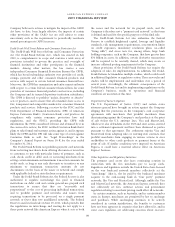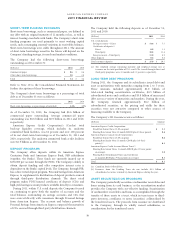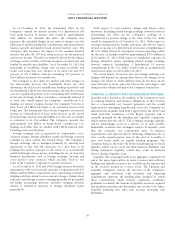American Express 2011 Annual Report Download - page 33
Download and view the complete annual report
Please find page 33 of the 2011 American Express annual report below. You can navigate through the pages in the report by either clicking on the pages listed below, or by using the keyword search tool below to find specific information within the annual report.
AMERICAN EXPRESS COMPANY
2011 FINANCIAL REVIEW
SHORT-TERM FUNDING PROGRAMS
Short-term borrowings, such as commercial paper, are defined as
any debt with an original maturity of 12 months or less, as well as
interest-bearing overdrafts with banks. The Company’s short-term
funding programs are used primarily to meet working capital
needs, such as managing seasonal variations in receivables balances.
Short-term borrowings were stable throughout 2011. The amount
of short-term borrowings issued in the future will depend on the
Company’s funding strategy, its needs and market conditions.
The Company had the following short-term borrowings
outstanding as of December 31:
(Billions) 2011 2010
Commercial paper $0.6$ 0.6
Other short-term borrowings 2.8 2.8
Total $3.4$ 3.4
Refer to Note 10 to the Consolidated Financial Statements for
further description of these borrowings.
The Company’s short-term borrowings as a percentage of total
debt as of December 31 were as follows:
2011 2010
Short-term borrowings as a percentage of total debt 5.4% 4.9%
As of December 31, 2011, the Company had $0.6 billion of
commercial paper outstanding. Average commercial paper
outstanding was $0.6 billion and $0.9 billion in 2011 and 2010,
respectively.
American Express Credit Corporation’s (Credco) total
back-up liquidity coverage, which includes its undrawn
committed bank facilities, was 62 percent and over 100 percent
of its net short-term borrowings as of December 31, 2011 and
2010, respectively. The undrawn committed bank credit facilities
were $2.9 billion as of December 31, 2011.
DEPOSIT PROGRAMS
The Company offers deposits within its American Express
Centurion Bank and American Express Bank, FSB subsidiaries
(together, the Banks). These funds are currently insured up to
$250,000 per account through the FDIC. The Company’s ability to
obtain deposit funding and offer competitive interest rates is
dependent on the Banks’ capital levels. The Company, through FSB,
has a direct retail deposit program, Personal Savings from American
Express, to supplement its distribution of deposit products sourced
through third-party distribution channels. The direct retail
program makes FDIC-insured certificates of deposit (CDs) and
high-yield savings account products available directly to consumers.
During 2011, within U.S. retail deposits the Company focused
on continuing to grow both the number of accounts and the
total balances outstanding on savings accounts and CDs that
were sourced directly with consumers through Personal Savings
from American Express. The account and balance growth of
Personal Savings from American Express outpaced the maturities
of CDs sourced through third-party distribution channels.
The Company held the following deposits as of December 31,
2011 and 2010:
(Billions) 2011 2010
U.S. retail deposits:
Savings accounts – Direct $ 14.6 $ 7.7
Certificates of deposit:(a)
Direct 0.9 1.1
Third party 10.8 11.4
Sweep accounts – Third party 11.0 8.9
Other deposits 0.6 0.6
Total customer deposits $ 37.9 $ 29.7
(a) The weighted average remaining maturity and weighted average rate at
issuance on the total portfolio of U.S. retail CDs, issued through direct and
third-party programs, were 22 months and 2.2 percent, respectively.
LONG-TERM DEBT PROGRAMS
During 2011, the Company and its subsidiaries issued debt and
asset securitizations with maturities ranging from 2 to 5 years.
These amounts included approximately $2.0 billion of
AAA-rated lending securitization certificates, $0.3 billion of
subordinated notes and certificates and $3.8 billion of unsecured
debt across a variety of maturities and markets. During the year,
the Company retained approximately $0.2 billion of
subordinated securities, as the pricing and yields for these
securities were not attractive compared to other sources of
financing available to the Company.
The Company’s 2011 issuances were as follows:
(Billions) Amount
American Express Credit Corporation:
Fixed Rate Senior Notes (2.8% coupon) $2.3
Floating Rate Senior Note (3-month LIBOR plus 85 basis points) 0.6
American Express Canada Credit Corporation
Fixed Rate Senior Notes (3.6% coupon) 0.6
Floating Rate Senior Note (1-month CDOR plus 105 basis
points)(a) 0.3
American Express Credit Account Master Trust:(b)
Floating Rate Senior Notes (1-month LIBOR plus 15 basis points
on average) 2.0
Floating Rate Subordinated Notes and Certificates
(1-month LIBOR plus 79 basis points on average) 0.3
Total $6.1
(a) Canadian Dealer Offered Rate.
(b) Issuances from the Lending Trust do not include $0.2 billion of
subordinated securities retained by American Express during the year.
ASSET SECURITIZATION PROGRAMS
The Company periodically securitizes cardmember receivables and
loans arising from its card business, as the securitization market
provides the Company with cost-effective funding. Securitization
of cardmember receivables and loans is accomplished through the
transfer of those assets to a trust, which in turn issues to third-
party investors, certificates or notes (securities) collateralized by
the transferred assets. The proceeds from issuance are distributed
to the Company, through its wholly owned subsidiaries, as
consideration for the transferred assets.
31
























